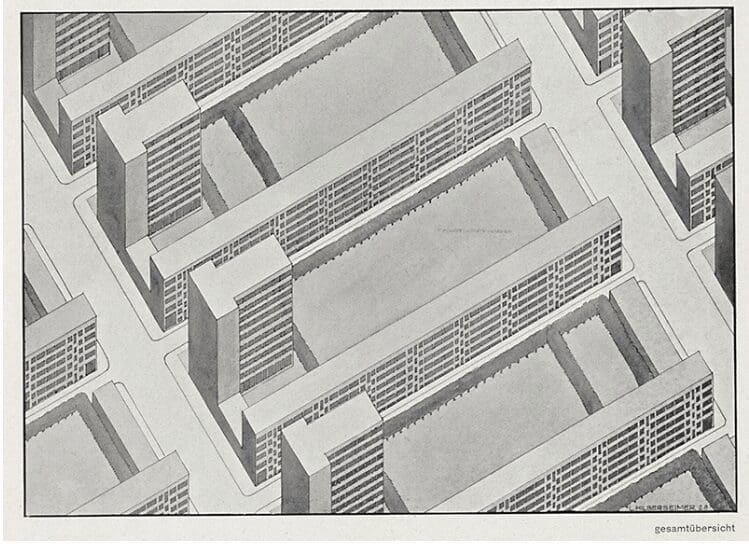Skeptics of guaranteed income tend to worry about the policy’s inflationary effects; absent rent regulation, for instance, one might expect housing costs to rise in proportion to the increase in disposable income generated by the policy. In a new working paper supported by JFI, “Universal Basic Income and the City,” Khalil Esmkhani, Jack Favilukis and Stijn Van Nieuwerburgh explore the effects of a UBI implemented at the city-level in New York City. The paper finds that, when financed through a progressive income tax, a UBI increases general welfare and—perhaps most notably—does not lead to housing market inflation. Their research sheds new light on the possible inflationary effects of basic income policies, and also suggests that the financing of a guaranteed income has significant implications for the policy’s outcomes. While the results are tentative, the paper already represents a major advance in the study cash transfer policy. In this post, I present an overview of the macroeconomic literature on basic income before turning back to the authors’ model, its findings, and a path for future work.
Research gaps on the macroeconomic effects of guaranteed income
Renewed interest in cash transfer policy has been accompanied by a push for pilot research to investigate its effects on recipients. In the United States, the Stockton California SEED demonstration and the Y-Combinator experiment both launched in 2019. Chicago, IL and Newark, NJ have both held task force meetings to explore the feasibility of basic income pilots. At the state level, policymakers in Maine, Massachusetts, and New York have introduced legislation to assemble task forces and launch pilots; the legislation in Maine was signed into law and task force activities began in Fall 2019. Outside the US, the Canadian province of Ontario and the government of Finland both ran limited pilot programs, which have since concluded.
While pilots can provide important insights into the short-run impacts of unconditional cash transfers, many researchers have noted that they typically cannot speak to the effects of a large-scale program. Most pilots are small, typically limited to several hundred or several thousand participants. A universal or near-universal benefit would, however, involve an extremely large transer—labor supply effects could lead to wage fluctuations, purchasing decisions could shift prices, and so on. Such market shifts could in turn generate behavioral responses with significant implications for net transfer amounts, interest rates, and GDP. A small pilot cannot speak to these “macro” effects because the actions of a few hundred or thousand pilot participants won’t cause a shift in wages or prices. Understanding what may happen with population-wide transfers is a pressing task, but pilots are thus far ill-equipped to address them.
One remedy is to design studies that take advantage of large-scale natural experiments. For example, a 2018 paper by Damon Jones and Ioana Marinescu explores the macroeconomic effects of the Alaska Permanent Fund Dividend, which goes to all permanent residents of Alaska, using a synthetic control Difference in Difference analysis. Similarly, JFI is currently developing a study to track the possible inflationary effects of a partial basic income (paid to 52,000 recipients, a third of the city’s population) implemented in Maricá, Brazil. Another option is to carefully develop large-scale studies for this purpose. A recent paper co-authored by Johannes Haushofer makes use of a saturated site design to provide the first experimental evidence on the general equilibrium effects of cash transfers.
But natural experiments are rare, and saturated site studies are expensive and difficult to coordinate. (To our knowledge, this is the first empirical study on general equilibrium effects of cash transfers in a research area that has seen more than two decades of work.) And, perhaps most obviously and most crucially, it is difficult to guess how generalizable findings from Maricá, Brazil or rural Kenya are to a major metropolitan area in the US—let alone an entire national economy.
Rigorous study of the macroeconomic effects of cash transfer policy must include modeling work. Macroeconomic models can be calibrated to explore the effects of a policy in a variety of contexts and the sensitivity of those effects to different assumptions about, for example, household labor market response to new taxes and benefits. Perhaps most importantly, these models allow us to explore the impact of alternate financing mechanisms on policy effects. A cash transfer policy financed with a Value Added Tax (VAT) may have very different effects on GDP, prices, and wages than one paid for through a progressive income tax; paying for a policy in part by eliminating other components of the social safety net may have important implications for net effects on income distribution and poverty.
Such models have, so far, seen little use in the research literature on cash transfer policy. A 2017 paper by Michalis Nikiforos, Marshall Steinbaum and Gennaro Zezza uses the Levy Institute macroeconometric model to simulate the effects of cash transfers. The paper’s results rested on three relatively strong assumptions: that households do not reduce labor supply in response to the cash transfer (there is no “income effect”); that households do not reduce labor supply in response to new income taxes (there is no “substitution effect”); that the economy is operating below capacity such that cash transfers can be both stimulative and, if financed in part by new government debt, will not lead to an increase in interest rates. In 2018, researchers at the University of Pennsylvania used the Penn Wharton Budget Model to examine and critique these findings.
This exchange represents the extent of macroeconomic modeling work on cash transfer policy at the time of publication.
What is macroeconomic modeling?
Macroeconomists often investigate the potential impacts of policy and economic shocks (e.g. a sudden increase in the price of oil) through the use of models. Models are abstract representations of the economy, and typically include market exchange, households, and/or businesses. The “agents” in the model produce and consume goods, sell their labor, and save. While the particular features of a given model depend on its complexity and the questions it is designed to answer, all macroeconomic models involve agents that interact in markets—buying and selling to maximize their wellbeing as represented by a “utility function,” which may also vary by agent. These interactions drive changes in prices, wages, production, consumption and savings, subject to the constraint that all markets in the model must “clear,” meaning that, at the prevailing wages and prices, supply must equal demand. This state is called “equilibrium,” and while the particular values of wages/prices/consumption/saving may fluctuate within the model over time, when the model is in equilibrium, all markets clear. Much work in macroeconomic modeling centers on perturbing a simulated economy with a stable equilibrium with a new policy or exogenous shock, to determine what the new equilibrium will look like when the proverbial dust has settled.
Within the field of macroeconomic models, one of the most dominant methods in the field is Dynamic Stochastic General Equilibrium Modeling. These are models which allow market conditions to vary over time, account for “random” variations in household and economic characteristics, and require all included markets to clear simultaneously. This last feature is particularly important. The analysis of a change in the price of a good or the wage offered for a job might initially focus on changes to a specific market. For example, if the price of a good goes up, people will buy and consume less of it. This is sometimes termed a “partial equilibrium analysis.” One might expect, however, that there will also be a variety of spillover effects on other markets: people may use the money they used to spend on that good on other things, or they may work more to be able to afford it, causing changes in the labor supply which could affect wages. In thinking about something like a guaranteed income policy we want to be able to account for such effects. General equilibrium analysis allows researchers to account for the strength of these spillover and feedback effects—beyond the immediate effects on a given market. Importantly, the ultimate effect of a change may be quite different than a partial equilibrium analysis might suggest. (For an overview of recent advancements in macroeconomic modeling as they relate to the study of inequality, see Kathryn Holston’s related post here).
The model and its scope
The model Esmkhani, Favilukis and Van Nieuwerburgh employ in their paper to study UBI in New York City is a Dynamic Stochastic Spatial Equilibrium model, with both overlapping generations and heterogeneous agents. It incorporates spatial components: households live in different “zones,” can build/buy/sell real estate and move, and may commute (at a cost) to work in other zones. This spatial dimension makes the model particularly useful for exploring the effects of policy on housing markets and housing affordability. Indeed, the model was initially developed to do just that: Favilukis and Van Nieuwerburgh made waves earlier this year when they used the model to understand the effects of rent control in New York City and found—contrary to prevailing wisdom—that its redistributional effects enhanced social welfare despite reductions in housing supply. Because the authors were particularly interested in the NYC housing market, the model is calibrated to reflect the particular characteristics of New York on a variety of dimensions including household characteristics, variations in housing stock, and population density in the core and periphery. Using an overlapping generations model is useful for considering how households’ decisions might change over their life-cycle, and including different types of agents (rather than one representative household) allows the researchers to include variation in household characteristics like wealth and earnings that are undoubtedly relevant for the study of UBI.
Using their DSSE model, the authors explore the potential effects of a $5,000 annual household transfer financed with a progressive income tax. While UBI is typically proposed as an individual rather than a household-level benefit, the unit of analysis in this model is households, meaning the model can’t discern variations in the impact of basic income by household composition (for example, comparing effects for households with and without children). The model instead provides estimates of the impact for the average household by city zone, household age, and household productivity. To help conceptualize the benefit, since the average household size in NYC is 2.67 people, it is roughly equivalent to $2250 per person per year. This is the same order of magnitude as the benefit offered by the Alaska Permanent Fund Dividend (usually $1500-2000 per person per year). This is much smaller than typical UBI proposals, which often discuss payments of six to twelve thousand dollars per year, but perhaps closer in size to the kind of cash transfer policy that could be feasibly implemented by a major city rather than the federal government.
The progressive income tax, which at baseline mirrors the actual marginal tax rates in New York City, is altered to finance this new expenditure. Income taxes can be adjusted by shifting the tax level without altering its progressivity (the relative difference in marginal tax rates across income categories remains constant) or by directly altering the progressivity. In the latter case, for example, one could alter marginal tax rates for the very wealthy without changing them for lower and middle income households. The paper explores financing the UBI through separate changes to the income tax’s level and progressivity, and builds a foundation to test optimal combinations of the two.
Like all such models, the paper’s DSSE has some important limitations. Because interest rates are exogenously given and do not change in response to taxes or savings behavior, the model effectively excludes bond markets from general equilibrium calculations. This is a reasonable assumption when looking at city-level policy; what happens in NYC alone does not have a large effect on national bond markets or interest rates. It is also a reasonable assumption when analyzing small open economies in an international setting, as the central banks of economically smaller countries have little control over the price of borrowing in international bond markets. Second, because the policy analyzed is city-level, the revenue to fund it is raised entirely within the city and only city residents receive it. At the US federal level, safety net policy is not subject to that constraint: states may raise more revenue for a program than their residents receive or vice versa. Taken together, these features mean we should exercise caution in extrapolating from city-level analysis to a national level guaranteed income policy.
Findings
The first important takeaway is that whether the program is financed by changing the tax level or progressivity, the UBI increases aggregate welfare. From the paper:
UBI is financed by income taxes which are, in their nature, distortionary. As is typical with distortionary income taxes, they reduce the incentive to work, resulting in households choosing more leisure hours and fewer working hours. This leads to lower city-wide output, income, and consumption. At the same time, UBI is a net transfer from wealthier to poorer households. Since poorer households have higher marginal utility, this is a transfer to those who need money the most. Under an equally weighted social utility measure, UBI is welfare improving. This is because, despite creating large distortions through the taxes needed to finance UBI, it provides a large benefit to those who need it most.
Given the assumptions of the model, the UBI makes individuals from the bottom half of the wealth distribution better off at the cost of a reduction in GDP. On average, hours worked fall between roughly 4 and 10 percent depending on which of the two financing methods is implemented, with the effect concentrated among low-wage households. Interestingly, the estimated effect on labor supply is very similar to that estimated during the North American Negative Income Tax experiments of the 1970s. There is a surprisingly large negative impact on wealth in the model driven both by poorer households engaged in less precautionary savings (because UBI provides a financial cushion) but also by wealthier households responding to higher taxes on capital income. Recall that interest rates in the model are fixed and exogenously given. As the authors note:
If UBI is instituted at a wider scale, then a model where interest rates are endogenous, and where there is a link between aggregate consumption and production is perhaps more appropriate. In such a model, the reduction in saving due to higher taxes would lead to higher interest rates as capital becomes scarce. This, in turn, would attenuate some of the reduction in saving and the effect on wealth.
This suggests that we should be cautious in extrapolating the observed wealth reduction to a national UBI, and that implementing a tax-financed guaranteed incomes at the state or municipal level could produce an undesirable side effect.
Second, and perhaps most interestingly, the authors find that contrary to common assumptions, a UBI does not generate housing market inflation. Instead, the combination of the benefits and taxes lead to a net reduction in rents and housing prices:
Housing consumption (dwelling size) falls by 2.8% and 6.8%. Lower demand for housing leads to lower rents, which fall by 3.8% and 9.0%, and lower house prices, which fall by 1.6% and 3.5%. The ratio of housing expenditures to income also falls, implying that housing becomes more affordable.
Rents go down both absolutely and relative to housing expenditure, leading to an increase in housing affordability. This comes, however, at the cost of a reduction in average dwelling size. These findings suggest that a UBI is unlikely to usher in a wave of inflation, and that pursuing UBI policy in coastal cities suffering from a shortage of affordable housing is not inherently misguided. Here we should note again the power of general equilibrium models to provide counter-intuitive findings; this is very much the opposite result as the one given by an informal partial equilibrium analysis.
The paper also discusses the spatial outcomes of a UBI, including changing neighborhood preferences and whether particular areas experience booms/blights as a result. These findings are sensitive to the manner in which the UBI is financed, with notably different results when the income tax level is altered rather than its progressivity. This further reinforces the idea that the details of financing matter, often in surprising ways. Further work on cash transfer policy must include deep research into financing mechanisms—the benefits such programs offer to society depend crucially on these details.
Future work
The remarkable research in “Universal Basic Income and the City” will be expanded in the coming months: The authors plan to perform a variety of robustness checks to determine how sensitive the findings are to the assumptions researchers made. For example, the authors note that their results may depend on the assumed labor supply elasticity (the strength of the response in labor supply to new taxes or benefits). Their model sets the Frisch Elasticity to 1, but there is much disagreement among economists as to the true value with estimates from microeconomic data ranging from 0 to 0.5 (recall the Levy Institute model assumes no labor response to new taxes and benefits at all) and from macroeconomic data ranging from 1 to 2. Though this may appear to be a dry, technical distinction it has major implications for policy design. Whether the modeling results on welfare and housing prices hold when this and other parameters are altered remains to be seen.
Beyond sensitivity analysis, one might be interested in modeling various disbursement amounts to mirror proposals like Andrew Yang’s Freedom Dividend or the benefit provided in the Stockton demonstration, or much larger transfers. A related question is what the optimal income tax might be for a given transfer amount. While the authors vary income tax level and progressivity separately, one could determine the combination of changes to both that would maximize welfare.
Regardless of the magnitude of the effect, which may change depending on other assumptions, the negative impact on wealth of a cash transfer policy implemented at a city level deserves further exploration. The authors suggest these effects could be mitigated if interest rates could respond to changes in savings behavior as would be the case for a policy implemented at a national level. So this is a natural area of inquiry in further modeling efforts.
And finally, income taxes are just one of several proposed funding mechanisms for a guaranteed income including a Value Added Tax (VAT) or a wealth tax. Sales taxes and VATs are often preferred by policy makers because they aren’t theorized to generate the same distortionary effects on incentives as income taxes (though, as noted, there is disagreement about the strength of these effects). On the other hand, because working class households consume a larger part of their incomes than the wealthy, sales taxes and VATs are, all else equal, regressive. A partial equilibrium analysis suggests the poor would, therefore, be worse off with a sales-tax financed UBI than an income tax-financed policy, but that may not be true when the net effects of the policy on the economy are calculated.
It is important to explore the effects of alternative financing mechanisms. Some of the modeling results presented here, like the decrease in wealth, may result from the use of income taxes. The DSSE model the authors use does not include intermediate goods in its abstract production functions so the model cannot look at a true VAT but it will be possible to explore the effects of financing a UBI through sales and wealth taxes and compare the results with those presented so far and potentially with financing plans that combine different tax types.
Conclusion
This working paper represents some of the early fruits of research efforts on the macroeconomic effects of guaranteed income policy. Already significantly advancing the literature on guaranteed income, it calls into question some assumptions about the likely effects of a cash transfer policy implemented in a major metropolitan area. We look forward to the final paper and will continue to support them wherever this modeling work leads.





















